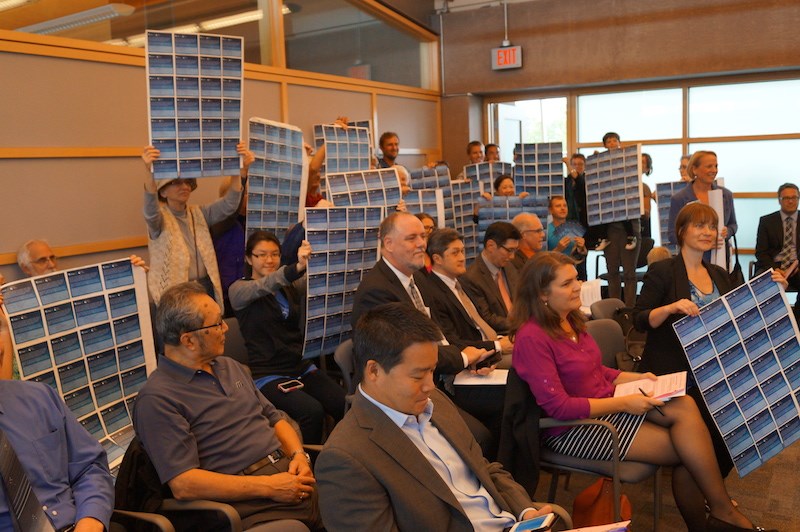Local Richmond residents concerned about climate change unofficially kick-started a nationwide environmental campaign by imploring city councillors to declare access to fresh air, clean water and healthy foods a human right.
About 20 activists, , known as the Richmond Blue Dots, packed a parks committee meeting at Richmond City Hall Wednesday afternoon to show politicians more than 1,500 signatures of residents who believe a healthy environment should be a Charter right in Canada.
They asked council members to draft a city declaration stating as much.
“You are already doing so much that supports the vision to the right to a healthy environment that we truly believe it’s time for you to package this all up, to call it what it is and to take recognition for the incredible work that is already under way,” said Sophika Kostyniuk, national organizing manager for the David Suzuki Foundation, which is spearheading the Blue Dot Tour.
It took little deliberation for the committee to move a motion to make the declaration. It stands to pass at the next council meeting on Oct. 14., likely meaning Richmond would become the first city in Canada to make such a declaration.
Kostyniuk said Richmond is facing a momentous time in its history when it comes to saving the Fraser River and green space. She praised the city’s eco-density initiatives, which aims to curb development on agricultural land, but she noted a number of industrial projects that stand to harm the environment such as a planned jet fuel facility, a coal terminal in nearby Surrey, and a proposed expanded oil sands pipeline (Trans Mountain) crossing the river further upstream.
Richmond's environmental ethos is enscribed in important official symbols: It is referred to as the ‘Child of the Fraser’ River on its coat of arms and its flag is adorned by three salmon.
It’s more than reasonable to contend that there is no other municipality in Canada at greater threat to rising sea levels than it (broadly accepted estimates have sea levels rising 1.2 metres by 2100 on the Fraser River, resulting in billions of dollars needed to upgrade the regional dyke system).
As such, the city has already declared in its Official Community Plan that it aims to reduce greenhouse gas emissions by 80 per cent from 2007 levels by 2050 (although GHG reductions are required by the Local Government Act and its goals are subject to higher government initiatives). It has undertaken initiatives such as geothermal heating of condominiums, electric vehicle charging stations and greater energy efficient homes.
The initiatives are taken to reduce emissions, which have led to human-driven global warming, a consensus scientific fact acknowledged by the Intergovernmental Panel on Climate Change.
Kostyniuk acknowledged it would take higher levels of government to cooperate in order to achieve climate change goals. She said the declaration is symbolic in nature but would still serve as a means for citizens to engage local government to be environmentally responsible.
Kostyniuk was joined at the meeting table by a local high school student named Gavin, who recently immigrated to Richmond from China.
“One of the differences between China and Canada is you can drink from the tap straight up. You don’t need to boil it or filter it,” said Gavin, who partook in several Blue Dot events over the summer, leading up to Wednesday’s presentation.
The Blue Dot Tour aims to engage grassroots, community movements that promote sustainable choices, such as local food and active transportation like cycling. It’s lobbying to amend the Charter of Rights to include a healthy environment as a right.
The tour officially launched in Newfoundland Wednesday evening.
The phrase “pale blue dot” was coined after an image of Earth was taken six billion kilometres away in 1990 by the Voyager 1 space probe, at the request of the late astrophysicist Carl Sagan.



